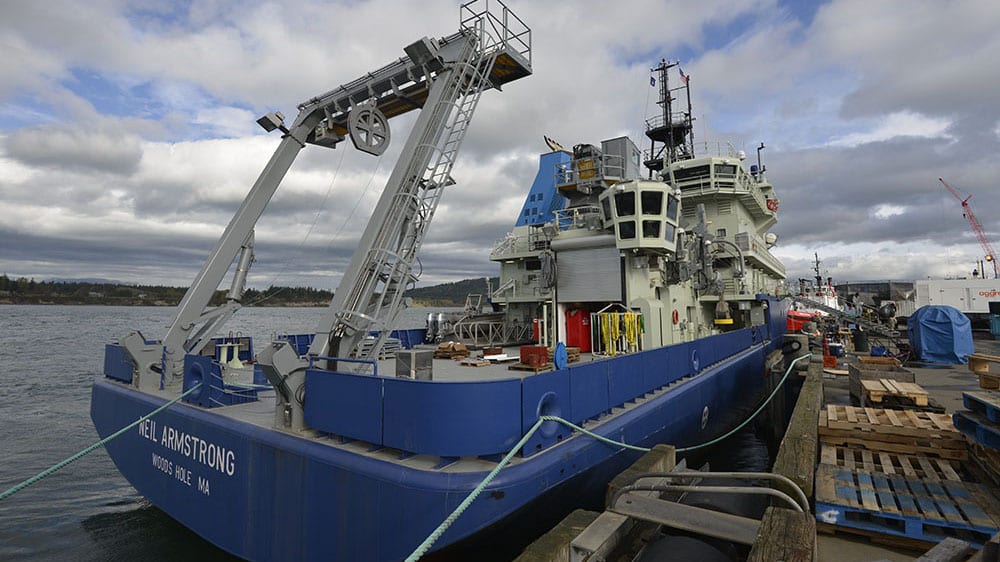WHOI researchers head back to sea after “pause” in research expeditions
 WHOI science team members will be onboard the R/V Neil Armstrong for 11 days to service the ocean observation equipment that is part of the National Science Foundation funded Ocean Observatories Initiative. (Photo by Ken Kostel, © Woods Hole Oceanographic Institution)
WHOI science team members will be onboard the R/V Neil Armstrong for 11 days to service the ocean observation equipment that is part of the National Science Foundation funded Ocean Observatories Initiative. (Photo by Ken Kostel, © Woods Hole Oceanographic Institution) June 5, 2020
After ten weeks of preparation, two weeks of isolation, documentation of negative COVID-19 tests, temperatures taken, and personal protective gear in place, nine science team members from Woods Hole Oceanographic Institution (WHOI) will depart on the R/V Neil Armstrong from Woods Hole, MA on Sunday 7 June 2020 for an 11-day expedition to service the Pioneer Array, a collection of ocean observing equipment off the New England coast, 55 miles south of Martha’s Vineyard.
The Pioneer mission is the first science expedition to leave Woods Hole following a “pause” in research expeditions imposed in March by UNOLS (University-National Oceanographic Laboratory System). UNOLS coordinates the U.S. academic research fleet ship schedules and has established guidelines for COVID prevention and mitigation aboard these ships. The journey aboard the R/V Armstrong is the second UNOLS science expedition to leave port with new stringent COVID-prevention protocols in place.
“We’ve worked extremely hard to implement measures that will help ensure the safety and health of our scientific party and crew members aboard the R/V Neil Armstrong,” said Al Plueddemann, chief scientist for the Pioneer Array expedition and a research scientist at WHOI. “It’s been an extensive planning and re-planning effort as our procedures had to adapt to changing circumstances.”
“We’ve had to reduce our scientific team significantly to ensure there is enough social distancing room aboard the ship, and condense the work into one cruise leg instead of two, which forced us to scale back the scientific mission, as well. But with the extensive precautionary measures in place, we are able to provide much needed service to the array, while also ensuring the cruise is sufficiently low risk to all personnel involved.”
The Pioneer Array is a collection of long-term oceanographic observing equipment that provides continuous ocean measurements over a period of years. The data collected are sent via satellite to a network server on shore for use by scientists, educators, and others. The data are available for everyone to use in as near real-time as possible. These long time-series data are helping to advance ocean research, understanding of ocean processes, and the changing ocean. The equipment requires regular maintenance to ensure that it can continually collect and disseminate biological, physical, and chemical ocean observations for the the oceanographic community and others who have come to rely on it. The Pioneer Array is one of five ocean observing arrays collecting real-time ocean data as part of the National Science Foundation funded Ocean Observatories Initiative.
Extensive precautionary measures were necessary to enable the ship and its passengers to conduct the science mission safely during the COVID-19 pandemic.
“Preparations began with trying to figure out the appropriate length and circumstances under which the scientific party and crew members could quarantine prior to heading out to sea, then evolved into gaining access to COVID-19 testing and labs to process the results, determining how to house the scientific party while in quarantine and onboard the vessel, and defining social distancing and protective gear that would be needed while at sea,” said Derek Buffitt, program manager for the Coastal Global Scale Node arrays, which includes the Pioneer Array.
Once such decisions were made, other practical considerations were tackled, such as how to:
- store used personal protective gear while at sea for onshore disposal,
- arrange bunks to minimize shared space,
- feed passengers and maintain social distances in shared common spaces,
- maintain the operational safety of the smaller science party,
- prioritize the scientific objectives to ensure the most effective use of the ship time, and
- respond if someone presented COVID-19 symptoms while at sea.
The Pioneer expedition departure on Sunday will represent the successful culmination of preparations for the new normal of conducting research at sea during a pandemic,” added Plueddemann.
Funded by the National Science Foundation, the Ocean Observatories Initiative is a science-driven ocean observing network that delivers real-time data from more than 800 instruments to address critical science questions regarding the world’s ocean. OOI data are freely available online to anyone with an Internet connection.
The Woods Hole Oceanographic Institution is a private, non-profit organization on Cape Cod, Mass., dedicated to marine research, engineering, and higher education. Established in 1930 on a recommendation from the National Academy of Sciences, its primary mission is to understand the ocean and its interaction with the Earth as a whole, and to communicate a basic understanding of the ocean’s role in the changing global environment. For more information, please visit www.whoi.edu.
